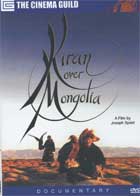
Kiran Over Mongolia 2005
Distributed by Cinema Guild, 115 West 30th Street, Suite 800, New York, NY 10001; 212-685-6242
Produced by Bulk Films
Directed by Joseph Spaid
DVD, color, 86 min.
Sr. High - Adult
Asian Studies, Social Sciences
Date Entered: 06/18/2007
Reviewed by Cliff Glaviano, Coordinator of Cataloging, Bowling Green State University Libraries, Bowling Green, OHThis documentary examines a subset of traditional Kazakh culture, the capture, training and hunting of wild game with golden eagles. Though the majority of Kazakhs live in Kazakhstan, they are a significant minority culture in Uzbekistan, Mongolia and China. As Kazakhs abandon the traditional nomadic (herding) lifestyle and move into urban areas, their culture is fading. In the countries in which the Kazakhs are a minority, traditional Kazakh culture is being replaced with the majority culture as the Kazakhs are assimilated. In Kiran over Mongolia, Kuma Uliksat, a young Kazakh man, travels hundreds of miles from his home to rugged Bayan Hongor in western Mongolia to seek out a master eagle trainer willing to train him in the traditional Kazakh art. Though eagle mastery has skipped a generation in Kuma’s family, Kuma wishes to honor his grandfather, a former eagle master, through his quest. The bird of choice among Kazakhs is the golden eagle, but not just any eagle: they seek to find a kiran eagle. Though kiran means “golden” in Kazakh, the qualities of kiran are large talons, wide beak, large wingspread, clearness of eye, and a fierce, hunter’s attitude. Kuma seeks a mentor who will find a kiran, and train Kuma to be a kiran master.
This is an extraordinary film. The quality of the audio and video is excellent. Great care is taken to depict the traditional Kazakh hunting garb, traditional home life, traditional music and song. It is filmed in one of the most beautiful and most forbidding locations on the planet. Superb sound engineering and careful editing finish the product. Best of all, the viewer is witness to the capture, training and semi-domestication of Kuma’s kiran, and is able to see traditional hunts: a two eagle hunt on horseback featuring Kuma and his mentor Kairatkhan; and Kuma’s hunt with his kiran to honor his grandfather once he returns home. During the training of Kuma and his kiran, Kairatkhan and his family teach Kuma (and the viewer) the centrality of eagle hunting in traditional Kazakh culture. Last, does an immersion into traditional Kazakh culture change Kuma’s relationship with his Mongolian fiancée? Early in the film Kuma states that he will likely lose his Kazakh culture through marriage. If a film can capture the beauty, the allure, the value of one’s culture, this one does it admirably.
Since the Kazakhs in western Mongolia were isolated from other Kazakhs for over seventy years, a good argument can be made that traditional Kazakh culture is strongest in western Mongolia. Writer/director Joseph Spaid is careful to let the Kazakhs speak for themselves: no narrator, English subtitles translate the Kazakh words, the interactions between the Kazakhs and the nuances of their language and singing add considerably to the almost palpable feeling of the Kazakh culture the film presents. Of what value is one’s culture? What value is tradition? Is one’s heritage partly dependent on one’s language, lifestyle, and custom? Kiran over Mongolia is highly recommended as a companion piece to studies of traditional cultures. It is a marvelous introduction to the study of humans and their society.